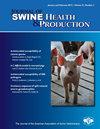Tonsil scrapings for porcine reproductive and respiratory syndrome virus detection in growing pigs under field conditions
IF 0.7
4区 农林科学
Q3 Agricultural and Biological Sciences
引用次数: 1
Abstract
Objective: The main objective of this study was to describe the use and limitations of tonsil scrapings (TS), oral fluids (OF), nasal swabs (NS), and environmental swabs (ES) to detect porcine reproductive and respiratory syndrome virus (PRRSV). Materials and methods: Two PRRSV-positive growing pig farms using different PRRSV control strategies were enrolled in this study. Sampling began approximately 52- and 21-days post PRRSV exposure for farms 1 and 2, respectively, and occurred once a month for four months using fixed spatial sampling. Samples for OF and ES were collected at the pen level and TS and NS samples were collected at the individual level. All samples were tested using reverse transcriptase-polymerase chain reaction (RT-PCR). Results: A total of 192 samples were collected over the study period: 48 TS, 48 OF, 48 NS, and 48 ES. Overall, 20 TS (41.6%), 0 OF (0.0%), 6 NS (12.5%), and 1 ES (2.1%) tested RT-PCR positive for PRRSV throughout this study. Implications: Tonsil scraping samples yielded more positive PRRSV RT-PCR results for longer time periods when compared to OF, NS, and ES for PRRSV detection in growing pigs. Tonsil scraping samples tested RT-PCR positive for PRRSV up to 168 days post exposure. Oral fluids, NS, and ES sampling methods for PRRSV detection in growing pig populations, particularly months after the initial infection or vaccination, should be used with caution given low RT-PCR positive samples found in this study.在田间条件下用扁桃体刮片检测猪繁殖与呼吸综合征病毒
目的:本研究的主要目的是描述扁桃体刮片(TS)、口腔液(of)、鼻拭子(NS)和环境拭子(ES)检测猪繁殖与呼吸综合征病毒(PRRSV)的用途和局限性。材料和方法:采用不同PRRSV控制策略的两个PRRSV阳性生长养猪场被纳入本研究。1号和2号农场分别在PRRSV暴露后约52天和21天开始采样,使用固定空间采样,每月进行一次,持续四个月。OF和ES的样本在笔水平上采集,TS和NS的样本在个人水平上采集。所有样本均采用逆转录聚合酶链式反应(RT-PCR)进行检测。结果:在研究期间共收集了192个样本:48个TS、48个of、48个NS和48个ES。在整个研究过程中,20个TS(41.6%)、0个of(0.0%)、6个NS(12.5%)和1个ES(2.1%)的PRRSV RT-PCR检测呈阳性。意义:与生长猪中的OF、NS和ES相比,扁桃体刮除样本在更长的时间内产生了更多阳性的PRRSV RT-PCR结果。在暴露后168天内,扁桃体刮除样本的PRRSV RT-PCR检测呈阳性。鉴于本研究中发现的RT-PCR阳性样本较低,应谨慎使用口服液、NS和ES采样方法来检测生长中的猪群中的PRRSV,特别是在首次感染或接种疫苗后的几个月。
本文章由计算机程序翻译,如有差异,请以英文原文为准。
求助全文
约1分钟内获得全文
求助全文
来源期刊
CiteScore
1.80
自引率
0.00%
发文量
29
审稿时长
>36 weeks
期刊介绍:
The Journal of Swine Health & Production (JSHAP) is an open-access and peer-reviewed journal published by the American Association of Swine Veterinarians (AASV) since 1993. The aim of the journal is the timely publication of peer-reviewed papers with a scope that encompasses the many domains of applied swine health and production, including the diagnosis, treatment, management, prevention and eradication of swine diseases, welfare & behavior, nutrition, public health, epidemiology, food safety, biosecurity, pharmaceuticals, antimicrobial use and resistance, reproduction, growth, systems flow, economics, and facility design. The journal provides a platform for researchers, veterinary practitioners, academics, and students to share their work with an international audience. The journal publishes information that contains an applied and practical focus and presents scientific information that is accessible to the busy veterinary practitioner as well as to the research and academic community. Hence, manuscripts with an applied focus are considered for publication, and the journal publishes original research, brief communications, case reports/series, literature reviews, commentaries, diagnostic notes, production tools, and practice tips. All manuscripts submitted to the Journal of Swine Health & Production are peer-reviewed.

 求助内容:
求助内容: 应助结果提醒方式:
应助结果提醒方式:


